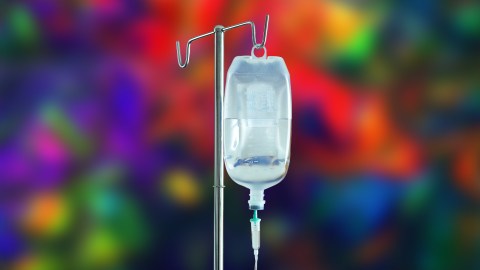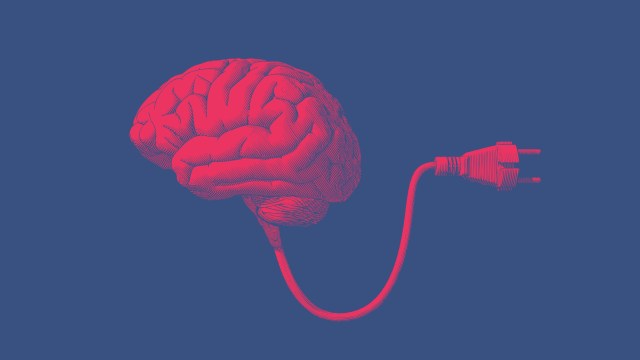DMT therapy appears effective for depression in phase 2 clinical trial

London-based biotech Small Pharma has released top-line data for its DMT-assisted therapy for major depressive disorder (MDD) — and the results are promising.
The phase 2a trial, which administered their DMT candidate SPL026 intravenously, found a “statistically significant and clinically relevant” reduction in depressive symptoms, at least over the short term.
The results suggest that “just one dose of SPL026, with supportive therapy, has marked antidepressant effects, all the way out to three months,” Carol Routledge, the chief medical and scientific officer of Small Pharma, tells Freethink, and a six-month, out-of-study follow up on trial participants is forthcoming.
The antidepressant activity was rapid, as well, occurring within one week after treatment.
“As good a set of results as we could expect,” Routledge says.
The potential of DMT-assisted therapy: Famed for the intensity of its brief hallucinogenic trips — with common sightings of “elves” and visits to other planes of existence — DMT is actually a naturally occurring chemical found in all manner of plants and animals, including being produced, in small quantities, in the human brain.
“It’s an experience that exists outside of our everyday perceptual understanding of reality,” UK-based psychiatrist Chloe Sakal, who participated as a volunteer in a study examining DMT’s effects on the brain, previously told Freethink. “It’s like experiencing the fifth dimension, but then only having four dimensions to describe it in.”
The rapidity of the trips means DMT has some advantages for psychedelic-assisted therapy. The idea is to get the benefits of a much longer psilocybin-type trip within a few minutes, potentially making the therapy more accessible; shorter sessions mean less expensive sessions, and not finding many hours to be, well, away.
Some research suggests that DMT may be able to produce psychological benefits without requiring a trip at all, although the jury’s very much still out on that.
“In lower animals, there is a suggestion that non-psychedelic (in animals, meaning non-behaviorally active) doses of DMT may benefit in animal models of anxiety, depression, and substance abuse,” Rick Strassman, clinical associate professor of psychiatry at the University of New Mexico and the author of The Psychedelic Handbook and DMT: The Spirit Molecule, tells Freethink.
“This may relate to effects on neurogenesis and neuroplasticity that do not seem dependent on behaviorally-active doses.”
One potential downside of the short and intense nature of DMT trips is that doing any kind of therapeutic guidance during the experience is quite difficult, Strassman notes. Small Pharma’s trial did not attempt guided therapy during the psychedelic experiences for that very reason.
The treatment: The phase 2a trial enrolled 34 patients with moderate to severe MDD. Any currently on pharmacological antidepressants were weaned off them prior to dosing — a future study will examine if this step is necessary, Routledge says.
The trial was conducted in two separate parts. In the first, a blinded, randomized, placebo-controlled stage, subjects were split into DMT and placebo groups.
While people who have never done psychedelics before may have a harder time distinguishing between a drug and a placebo, given DMT’s intense effects, subjects were “functionally unblinded,” Routledge says, even though they were not told what they were receiving.
“So the way that we kept that part of the study blinded is that … all those clinical staff that did the efficacy scales and the safety and the tolerability, they were blinded to treatment,” Routledge says. Staff did not know what patients had received, were not present at dosing, and were told to not ask any questions about psychedelic experiences.
Doses were administered intravenously, with psychedelic experiences lasting from 20 to 30 minutes. IVs were chosen so that the drug was completely bioavailable. Small is currently looking into intramuscular injection and other, more comfortable and convenient routes as well.
The second part of the study was open-label, meaning everyone received, and knew they received, DMT. For placebo participants, this was their first dose. This second phase helped examine if one or two doses made a difference, as well as durability of antidepressant effect.
Research thus far suggests that the “therapy” part of psychedelic-assisted therapy is important, with best practices involving preparation sessions — in which the patient learns what they may experience and lays out their treatment goals — and integration sessions, helping to make sense of what they felt and carry it forward through their lives.
Patients were offered preparation therapy sessions before their psychedelic experience: one during initial screening and a second the day before the infusion, with the option of a third right before dosing.
Integration sessions took place after they were completely out of their trip and another one in the morning, pre-discharge, after overnight observation, with the option to speak to therapists at some follow up assessments.
After analysis, the company plans on using the data to design a larger, longer phase 2b trial.
The results: One week after treatment, the DMT patients had, on average, 10.8 point lower MADRS scores compared to placebo patients, and they were 7.4 points lower after two weeks. For comparison, a 2 to 5 point reduction would be considered successful for a common antidepressant, Routledge says.
There was no apparent difference in one dose versus two, with the effects still holding at three months either way. At the three month mark, 57% of patients’ MDD was in remission, defined as a total MADRS score of 10 or less.
“The data are intriguing,” Bryan Roth, distinguished professor of pharmacology at the University of North Carolina, tells Freethink via email. “It will be important to see how these results agree with other ongoing studies with DMT.”
While less studied compared to psilocybin, ketamine, and MDMA, DMT is receiving more attention lately, including recently in a trial by researchers at Yale.
It is important to note this is only top-line data, and the results have yet to be published in a peer-reviewed journal — the full data is expected to be so, Routledge says.
After analysis, the biotech will use the data to set up a larger, longer phase 2b study, with hopes to begin that in the first half of this year.





